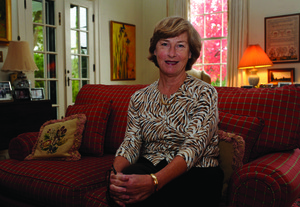

Betsy K. White is the author of Backcountry Makers.
John Erhart Rose probably made the tall case for Valentine Baugh's clock featured in last month's article, but we're sure he made the elaborately-carved secretary seen here because he signed it.
Hidden within its unseen inner structure in a faint penciled inscription is, "Made by John Erhart Rose from East Tennessee, Knoxville, July 28th 1833." Rose often signed his furniture, a boost to modern research that finds few signatures. Rose not only signed his pieces but dated them and placed them in the locale where he made them ... another lucky break for those of us trying to follow the careers of early artisans who sometimes moved around quite a lot.
Rose was born in Pennsylvania in 1767 into a German family of artisans and was already 66 and a mature cabinetmaker when he made the mahogany and rosewood secretary. He made the case for Valentine Baugh's clock almost 20 years earlier, and the time difference shows. Rose's clock case of restrained simplicity reflects its earlier date, 1814, as well as the preference of its Virginia market. Rose made it while he lived in Abingdon, and several other known pieces handed down in families there bear the same Chippendale and Sheraton hallmarks of his early furniture.
The Knoxville secretary was quite possibly his masterpiece and allowed him to exercise what seems to have been a natural tendency to exuberance. We don't know why he left Abingdon, where he had married and begun his family, but perhaps it was the larger market taste that compelled him to transfer his trade to Knoxville around 1820, where he responded to styles that included carving and veneers. It's not surprising, since this is what he was trained for. As the son of Reading, Pa., clockmaker, Daniel Rose, John was sent to Philadelphia at age 14 to serve an apprenticeship as a cabinetmaker at a time when carved furniture was popular. John likely remained there learning his craft for the standard seven years, allowing him to arrive in Abingdon with the credentials of a first-rate cabinetmaker.
Rose stayed in Knoxville for close to 10 years before returning to Abingdon to re-settle his family. Documentary records, as well as his signed furniture, tell us he continued to practice his trade for many more years, moving up and down the Great Wagon Road that connected Pennsylvania to Southwest Virginia and Northeast Tennessee.
By 1855, it seemed his traveling days were over, and John Rose turned up again in Abingdon's tax records. He died there five years later at age 93. Perhaps because Abingdon was his first home outside Pennsylvania and his neighborhood included artisan families like his of German heritage, Rose had left his family there all those years of his travels. Three sons had even carried on his legacy as Abingdon cabinetmakers. So it was to Abingdon that he came home at the end. And it could just be that he decided it was time to stay put where he had much to show for his life ... in Southwest Virginia and Northeast Tennessee.
This is the second of a series of articles related to Betsy K. White's new book Backcountry Makers: An Artisan History of Southwest Virginia & Northeast Tennessee. Featuring more than 200 color images, it is currently in publication by the University of Tennessee Press. Backcountry Makers is White's second book on the history of the region's material culture. The first, Great Road Style: the Decorative Arts Legacy of Southwest Virginia & Northeast Tennessee was published in 2006 by the University of Virginia Press.